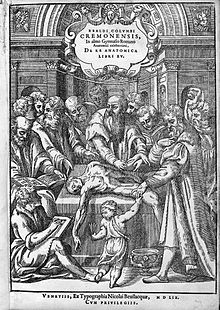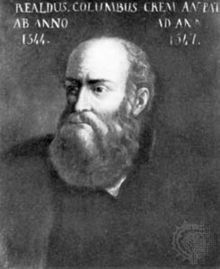- Realdo Colombo
-
Realdo Colombo was an Italian professor of anatomy and a surgeon at the University of Padua between 1544 and 1559.
Contents
Early life and education
Matteo Realdo Colombo or Renaldus Columbus, was born in Cremona, Lombardy to an apothecary named Antonio Colombo. Although little is known about his early life, it is known he took his undergraduate education in Milan and he appears to have pursued his father's profession for a short while afterwards. He left the apothecarys' life and apprenticed to the surgeon Giovanni Antonio Lonigo, under whom he studied for 7 years. In 1538 he enrolled in the University of Padua where he was noted to be an exceptional student of anatomy. While still a student, he was awarded a Chair of Sophistics at the university. In 1542 he returned briefly to Venice to assist his mentor, Lonigo.
Academic career
In 1543 he returned to Padua to take over the position of Andreas Vesalius, who had travelled to Switzerland to oversee the printing of his book De Humani Corporis Fabrica. Colombo remained in Padua in this capacity for two years before traveling to Pisa at the behest of Cosimo I de Medici. While in Pisa, he worked extensively with Michelangelo. He intended to collaborate with Michelangelo on an illustrated anatomy text to rival De Fabrica but this never came to pass, likely due to Michelangelo's advanced age. In 1548 Colombo took a position at the Sapienza in Rome which he kept until his death in 1559. Because Colombo was not an expert of Galen, the anatomical authority of his time, and because of his very public disputes with the revered Vesalius and Falloppio, he was never very highly regarded in Italy.
Colombo and Vesalius
The relationship between Colombo and Vesalius is not entirely clear. It is often thought that Colombo was a student of Vesalius, but this may not have been the case. Regardless, they had become bitter rivals by 1555. While teaching Vesalius' classes in 1543, Colombo pointed out several errors Vesalius made, most notably attributing properties of cows' eyes to the eyes of humans. Although Vesalius has been much maligned for correcting Galen, Colombo was the first person to criticize him for his own mistakes. When Vesalius returned he was outraged. He publicly ridiculed Colombo, calling him an "Ignoramus" and stating that "what meager knowledge [Colombo] has of anatomy he learned from me"[citation needed] on a number of occasions. Despite Vesalius' claims, it is likely that Colombo was a proper colleague of Vesalius rather than a student. For one thing, Vesalius attributes many of his discoveries in De Fabrica to Colombo who is referred to as a, "very good friend." Vesalius and Colombo were also from very different academic backgrounds. Vesalius was a Galenic expert, trained in Leuven, whereas Colombo began his study of anatomy as a surgeon. Finally, Colombo refers frequently to Lonigo as his teacher of surgery and anatomy, never mentioning Vesalius.
Colombo and Falloppio
 Title page of De Re Anatomica
Title page of De Re Anatomica
Colombo published his only work, De Re Anatomica, in 1559 shortly before his death. Many of the contributions made in De Re Anatomica overlapped the discoveries of Gabriel Falloppio, most notably the discovery of the clitoris. Falloppio published his own book, Observationes Anatomicae, in 1561 and claimed that he had written the work four years prior[citation needed]. This is unlikely as Falloppio's work contains several thinly veiled references to De Re Anatomica. In 1574 G.B. Carcano, a student of Falloppio, formally charged Colombo of plagiarism, although since Colombo had been dead for over a decade nothing came of these charges.
Contributions to anatomy
Colombo made several important advances in anatomy, including the discovery of the pulmonary circuit which paved the way for William Harvey's discovery of circulation years later. In the Galenic tradition, blood passed between the ventricles of the heart through micropores in the heart's septum and that venous blood became arterial blood in the left ventricle of the heart where air was supplied by the pulmonary vein. During vivisections of dogs and other animals, Colombo repeatedly found only blood, and no air, in the pulmonary vein. In his model, venous blood travelled from the heart to the lungs where it was mixed with air and then returned to the heart. Although the permeability of the septum was denied by Michael Servetus in Christianismi Restitutio in 1553 and by Ibn al-Nafis in the 12th century, Colombo was the first to describe an alternative. In addition to the pulmonary circuit, Colombo also discovered that the main action of the heart was contraction, rather than dilation as had previously been thought. Both of these discoveries were later confirmed by William Harvey.
Much cited is Columbus' naming and description of the clitoris as "Amor Veneris, vel Dulcedo Appelletur" (It should be called the love or sweetness of Venus). [1]
See also
References
- ^ Harvey E. Anatomies of rapture: Clitoral politics/Medical blazons. Signs. 27(2) Winter 2002, 315-46
Realdo Colombo in fiction
- Andahazi, Federico (1998). The Anatomist. ISBN 0-385-49400-9.
External links
Categories:- 1510s births
- 1559 deaths
- 16th-century Latin-language writers
- History of anatomy
- Italian anatomists
- Italian surgeons
- Medical educators
- People from Cremona
- 16th-century Italian physicians
- University of Padua alumni
- University of Padua faculty
Wikimedia Foundation. 2010.

